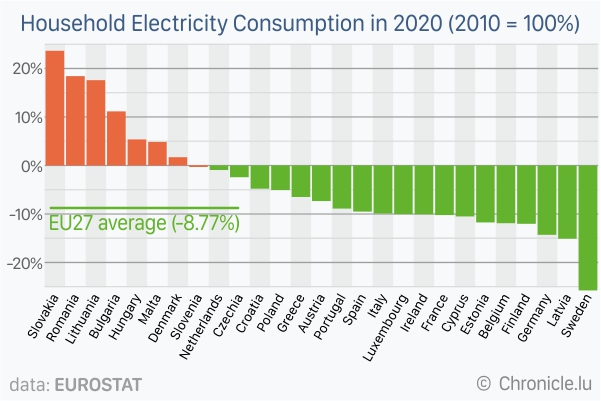
In 2020, on average 3,586 Kwh (Kilowatt-hour) of electricity was used per household in Luxembourg, a 10.03% decrease compared to 2010 (3,986 Kwh), data extracted from European statistics agency Eurostat have shown.
The average electricity consumption per household in the European Union (EU) in 2020 was 3,641 Kwh, a marginal increase from 2019 (3,608 Kwh) but a net decrease of 8.77% compared to 2010 (3,991 Kwh).
Of the 27 EU Member States, only seven reported a net increase in 2020 compared to 2010, with Slovakia recording the highest increase in household electricity consumption of 23.65% in 2020 (2,876 Kwh) compared to 2010 (2,326 Kwh), followed by Romania (18.43%), Lithuania (17.60%) and Bulgaria (11.17%).
The largest drop in electricity consumption per household in the EU between 2010 and 2020 was reported in Sweden (down 25.77%), followed by Latvia (down 15.11%), Germany (down 14.28%) and Finland (down 12.04%).
While countries with relatively long periods of warm or cold weather increased the overall electricity consumption, as evident by 8,018 Kwh of electricity consumed per household on average in Finland in 2020, followed by Sweden (7,652 Kwh) and Cyprus (5,405 Kwh), the new energy efficient electric appliances and consumables together with better insulated residential constructions contributed to the decrease in electricity consumption per household in general.
In absolute terms, Romania reported the lowest electricity consumption at 1,812 Kwh per household in 2020, followed by Latvia (2,033 Kwh) and Poland (2,061 Kwh).
In total, 713.74 Twh (terawatt-hour) of electricity was consumed by households in the EU in 2020, 2.25% lower than that in 2010 (730.177 Twh). In Luxembourg, total consumption by households equated to 939.63 Gwh (gigawatt-hour) of electricity in 2020, a 15.3% increase compared to 815.15 Gwh consumed in 2010.








